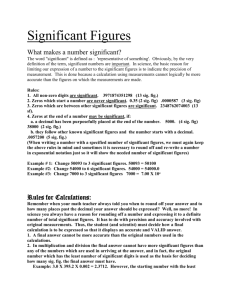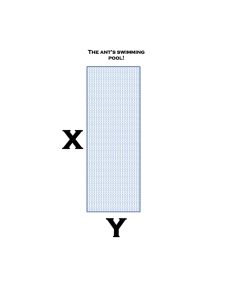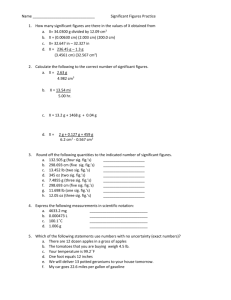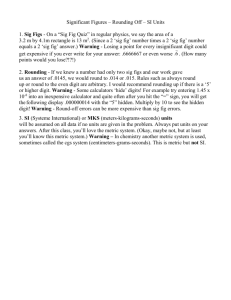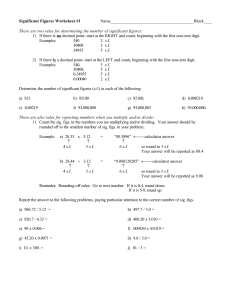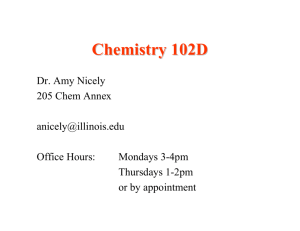工作紙
advertisement
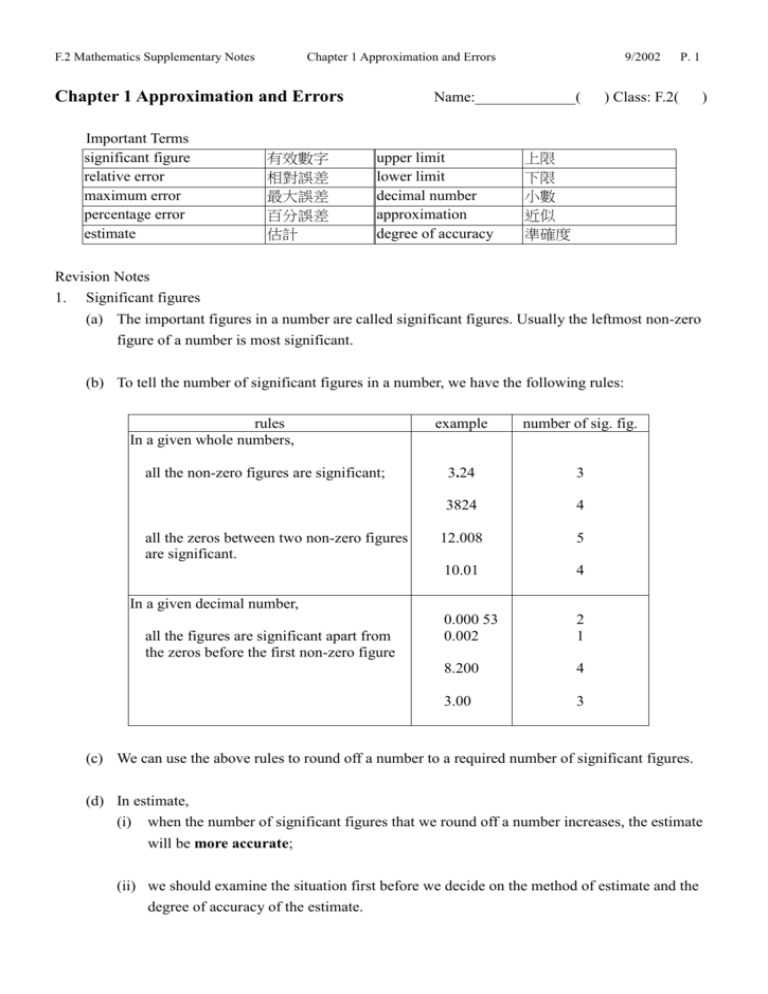
F.2 Mathematics Supplementary Notes Chapter 1 Approximation and Errors Chapter 1 Approximation and Errors Important Terms significant figure relative error maximum error percentage error estimate 有效數字 相對誤差 最大誤差 百分誤差 估計 9/2002 Name:_____________( upper limit lower limit decimal number approximation degree of accuracy P. 1 ) Class: F.2( ) 上限 下限 小數 近似 準確度 Revision Notes 1. Significant figures (a) The important figures in a number are called significant figures. Usually the leftmost non-zero figure of a number is most significant. (b) To tell the number of significant figures in a number, we have the following rules: rules In a given whole numbers, all the non-zero figures are significant; all the zeros between two non-zero figures are significant. example number of sig. fig. 3.24 3 3824 4 12.008 5 10.01 4 0.000 53 0.002 2 1 8.200 4 3.00 3 In a given decimal number, all the figures are significant apart from the zeros before the first non-zero figure (c) We can use the above rules to round off a number to a required number of significant figures. (d) In estimate, (i) when the number of significant figures that we round off a number increases, the estimate will be more accurate; (ii) we should examine the situation first before we decide on the method of estimate and the degree of accuracy of the estimate. F.2 Mathematics Supplementary Notes Chapter 1 Approximation and Errors 9/2002 P. 2 Example 1.Round off 321 996 , correct to (a) 2 significant figures; (c) 4 significant figures (b) 3 significant figures; Solution: (a) 321 996 = 320 000 (2 sig. fig.) (b) 321 996 = 321 000 (3 sig. fig.) (c) 321 996 = 321 000 (4 sig. fig.) Example 2.Round off 310.103 to (a) 5 significant figures (c) 3 significant figures (b) 4 significant figures (d) 2 significant figures Solution: (a) 310.103 = 310.10 (5 sig. fig.) (b) 310.103 = 310.1 (4 sig. fig.) (c) 310.103 = 310 (d) 310.103 = 310 2. (3 sig. fig.) (2 sig. fig.) Errors (a) maximum error = (b) relative error = 1 the difference between the finest markings on the measuring instrument 2 maximum error measured value (c) percentage error = relative error 100% (d) When the relative error or the percentage error is large, the degree of accuracy is low. (e) lower limit = measured value – maximum error upper limit = measured value + maximum error Example 3. In 1999, the registered readership of public libraries was 1 394 000 500. Find the percentage error of this number, correct to 2 significant figures. Solution: maximum error = 500 percentage error = 500 100% 1394000 = 0.036% Example 4. By measurement, the thickness of a pack of 500 pieces of A4 paper is 54 mm with a relative error of 1 . Find the range of the true thickness. 135 F.2 Mathematics Supplementary Notes Solution: maximum error = 54mm Chapter 1 Approximation and Errors 9/2002 P. 3 1 = 0.4 mm 135 upper limit =(54+0.4)mm = 54.4 mm lower limit = (54-0.4)mm = 53.6 mm the range of true thickness of this pack of paper is between 53.6mm and 54.4mm. Exercise A Level 1 1. State the number of significant figures in each of the following numbers (a) 373.4 (b) 203 373.4 has 4 significant figures (c) 133.01 2. 3. (d) 0.1090 ________________________ ________________________ Round off the following numbers: (a) 18.89 to 1 decimal places ________________________ (b) 2384 to the nearest ten ________________________ (c) 3.141 to the nearest tenth ________________________ (d) 127.01 to the nearest integer ________________________ Express the fraction 22 as a decimal correct to 7 (a) three significant figures ________________________ 4. ________________________ (b) three decimal places ________________________ Express each of the following measurements in the units given in the brackets. Round off the result correct to 3 significant figures. (a) 4 301 cm [m] 4 301 cm = (4 301 (b) 5 051 g [kg] 1 )m 100 = 43.0 m (3 sig. fig.) (c) 1.25 L [mL] (d) 17 cm2 [mm2] F.2 Mathematics Supplementary Notes 5. Chapter 1 Approximation and Errors 9/2002 P. 4 The distance between two stations is 2.0 km , correct to the nearest 0.1 km. For the approximation, find (a) the maximum error (b) the relative error ________________________ ________________________ ________________________ (c) the percentage error ________________________ ________________________ ________________________ 6. The diagonal of a rectangle is 14cm, correct to 2 significant figures. For the approximation, find (a) the maximum error (b) the relative error ________________________ ________________________ ________________________ (c) the percentage error ________________________ ________________________ ________________________ 7. American sprinter Tim Montgomery smashed the world 100-metres record when he clocked 9.78 seconds at the IAAF Grand Prix Final. Find the maximum error, upper limit and lower limit of the time. 8. The measured weight of a man is 65kg. If the percentage error is 2%, find the range of the true weight of the man. F.2 Mathematics Supplementary Notes Chapter 1 Approximation and Errors 9/2002 P. 5 ==============================Optiontal=========================== 1. Among the following number, select the one(s) that is (are) closer to 0.90 than to 0.91. 0.9054 0.9077 0.9045 0.9008 0.9080 (Ans: 0.9045,0.9008) 2. Round off the number 0.9999 to 3 sig. fig. (Refer to: http://www.fed.cuhk.edu.hk/~fllee/mathfor/edumath/9806/14mak_ty.html 資料提供: F2A 李雨翔同學) 3. The length of a square is 10 cm. If the percentage error is 10%, find the range of the true area of the square. (Ans: 81cm2 –121cm2) 4. The approximate values of two numbers are 2.0 and 4.5 correct to 1decimal place. (a) Find the percentage errors of 2.0 and 4.5. (b) Find the percentage error of 2.0 4.5. (c) Find the percentage error of 4 .5 . 2 .0 (d) What do you notice when you compare the percentage errors from parts(a) , (b) and (c)? 常用網址:http://www.puiching.edu.hk/~maths/ F.2 Mathematics Supplementary Notes Chapter 1 Approximation and Errors 9/2002 P. 6 相關網址: http://lectureonline.cl.msu.edu/~mmp/applist/sigfig/sig.htm http://www.phys.unt.edu/PIC/significant_figures.htm http://brad.tcimet.net/java_samples/sigfigs/autogen_SigFigs.html http://chemed.chem.purdue.edu/genchem/topicreview/bp/ch1/sigfigs.html 數學課外閱讀: 測量長度: 在測量長度的歷史背後,有許多引人入勝的故事。各種測量方法明顯反映出當時社會的需要,研究 過去使用的測量方法,可以使我們更加了解今天使用的度量衡。 用身體測量 許多長度測量單位都是以人的身體為基準的。例如埃及人曾用下面的長度測量單位: 指幅(digit) = 1 根手指寬 掌寬(palm) = 4 指幅 手寬(hand) = 5 指幅 腕尺(cubit) = 由肘至指尖的距離 = 28 指幅 羅馬人使用腳長及走一步的距離作為長度測量單位,後者是指腳跟從離開地面至下一次接觸地 面間的距離。羅馬的 1 哩相當於 1 000 步,用來測量他們的軍隊行進了多遠。 由於這些單位並不確定,因而有必要定出標準單位。12 世紀,英國國王亨利一世(King Henry I) 下令用碼作為長度單位,1 碼就是從他鼻尖到姆指端的距離。後來愛德華一世(King Edward I)又以 一根鐵棒的長度為標準碼,並規定 1 碼的 1/3 為 1 英尺。 <<聖經>>中許多測量值也都是用肘(即腕尺)來表示,例如描述巨人歌利亞的身高(撒母耳記上 篇),諾亞方舟的大小(創世記)及洪水的深度(創世記),所羅門王各個宮殿的規模等等。 隨著科學的發展,我們對量度的精確度要求越來越高,國際間都已有一個共同的標準,例如: (資料來源: http://www.bipm.fr/enus/3_SI/base_units.html) Quantity Length Unit metre m Mass kilogram kg Time second s Definition The metre is the length of the path travelled by light in vacuum during a time interval of 1/299 792 458 of a second. The kilogram is the unit of mass; it is equal to the mass of the international prototype of the kilogram. The second is the duration of 9 192 631 770 periods of the radiation corresponding to the transition between the two hyperfine levels of the ground state of the caesium 133 atom.
